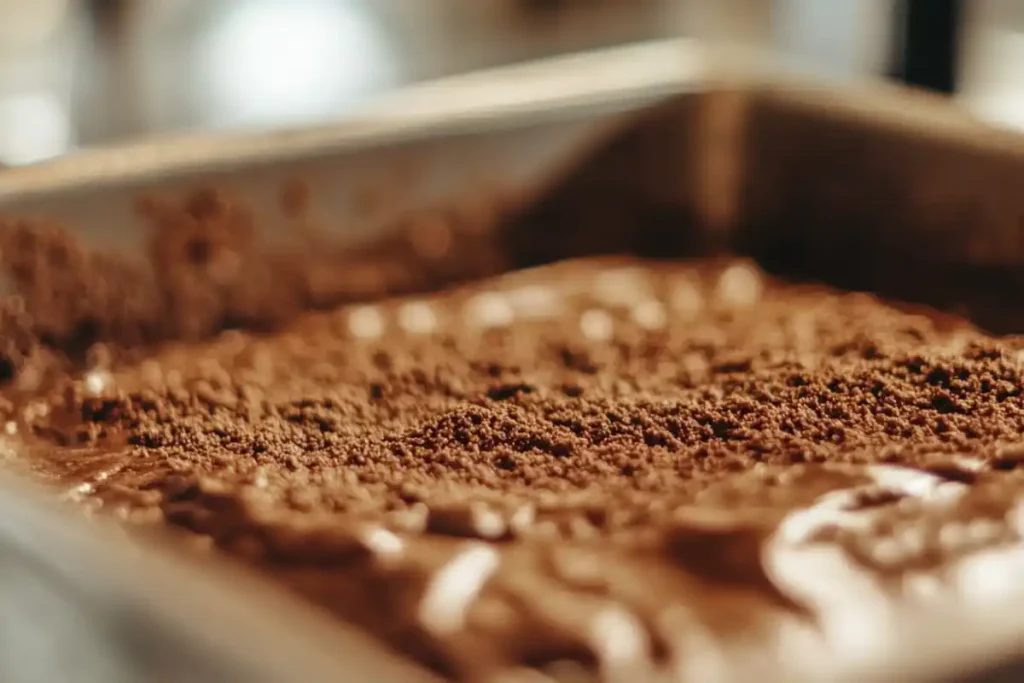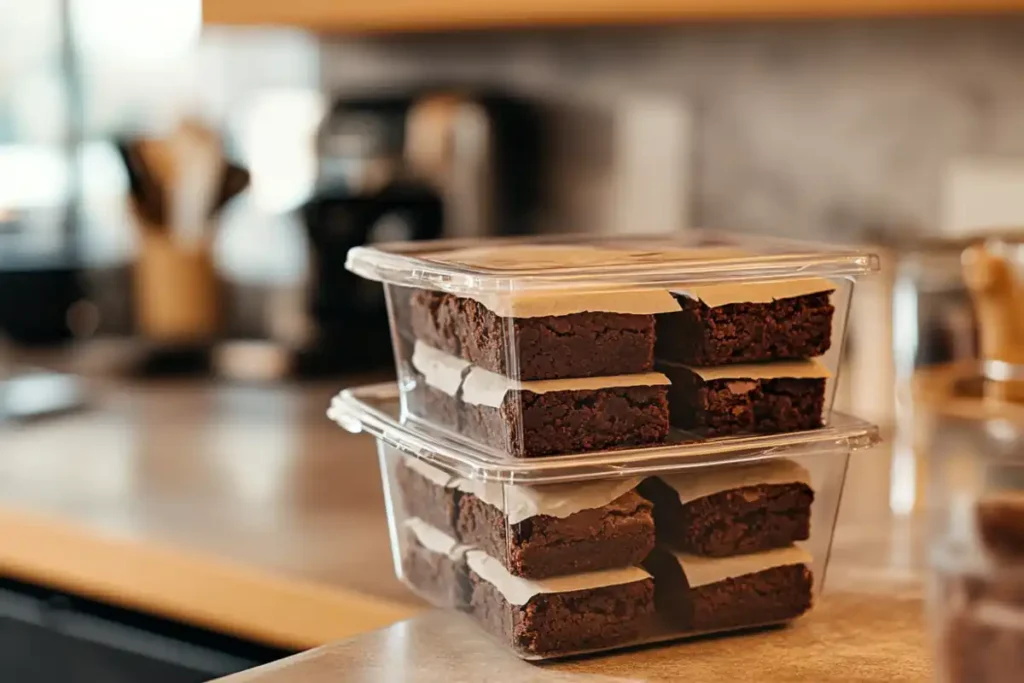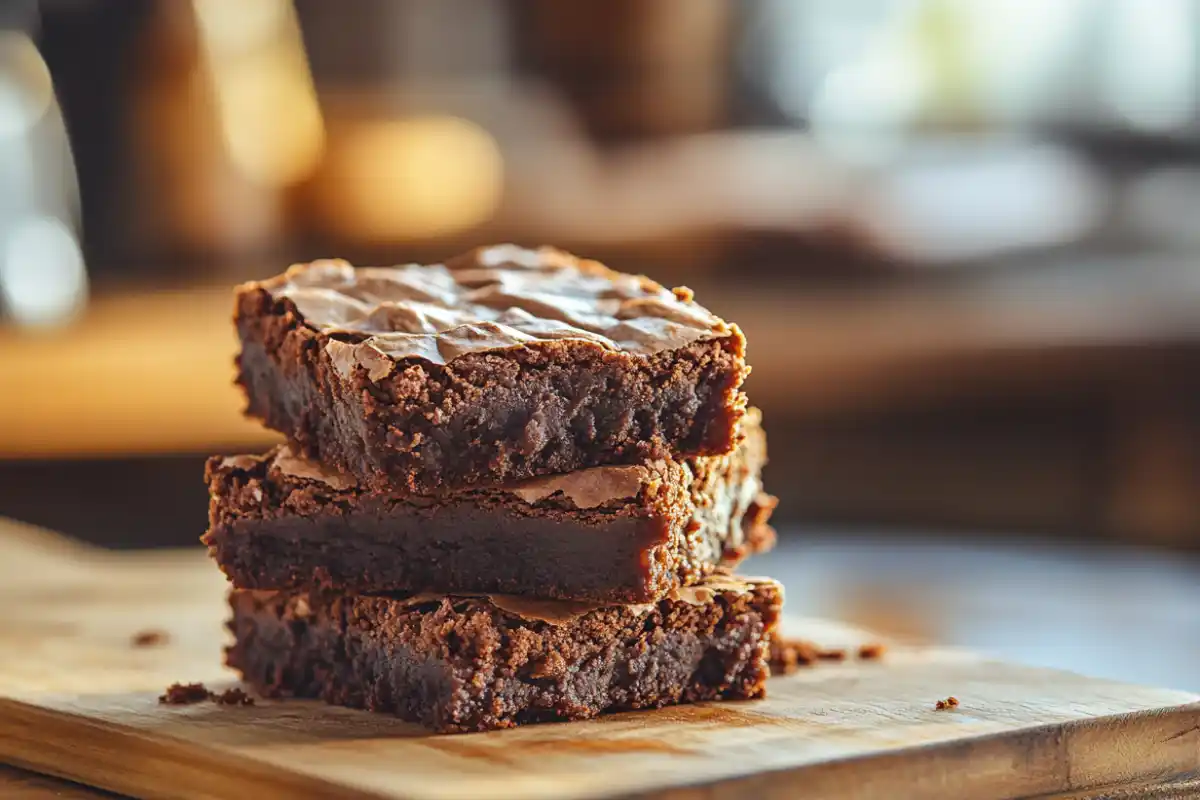Who doesn’t love a fudgy, chewy brownie with a soft center and crispy edges? But here’s the thing—brownies don’t always stay that way! If not made and stored properly, they can dry out, become too firm, or lose their delightful chewiness.
So, how do you keep brownies soft and chewy? This ultimate guide covers everything you need to know, from choosing the right ingredients and baking techniques to the best storage methods. You’ll also learn about common mistakes that make brownies hard and how to fix them.
Let’s dive in and unlock the secrets to perfectly soft and chewy brownies every time!
Understanding Brownie Texture
A brownie’s texture can range from cakey to fudgy, but if your goal is soft and chewy brownies, you need to understand what makes them that way. From ingredient choices to baking methods, several factors affect how your brownies turn out.
What Makes Brownies Soft and Chewy?
Brownies get their signature chewiness from a careful balance of fat, sugar, and baking techniques. Here’s how each element contributes:
- The Role of Fat: Brownies with a higher fat content tend to be softer and denser. Using butter and oil together can enhance both moisture and chewiness. Butter adds flavor, while oil prevents brownies from becoming too dry.
- Sugar’s Impact on Moisture: Brown sugar is your best friend when aiming for a chewy texture. Its higher moisture content helps retain softness, while granulated sugar provides structure.
- Eggs for Structure and Texture: Using whole eggs contributes to a firm but tender bite. For an extra chewy texture, adding an extra egg yolk works wonders!
- The Right Flour-to-Fat Ratio: Less flour and more fat result in a softer brownie. Stick to all-purpose flour for the best balance—cake flour makes them too delicate, while bread flour makes them too tough.
Why Do Brownies Become Hard or Dry?
Even the best brownies can turn dry and hard if not handled correctly. Here’s why this happens:
- Moisture Loss Over Time: Air exposure draws moisture out of baked goods. If brownies aren’t stored properly, they dry out quickly.
- Overbaking is a Major Culprit: Baking too long sucks the moisture out, leaving you with dry, crumbly brownies. Always pull them out of the oven when they’re slightly underbaked—they’ll continue cooking as they cool.
- Incorrect Ingredient Ratios: Using too much flour or too little fat can result in a cakier, drier texture.
- Improper Cooling Techniques: Letting brownies cool completely on a wire rack can cause excessive moisture loss. Instead, cool them in the pan to lock in softness.
Now that you know what affects brownie texture, let’s explore how to make the perfect batch by choosing the right ingredients!
Choosing the Right Ingredients for Soft Brownies
The secret to how to keep brownies soft and chewy begins with the right ingredients. Each component plays a key role in achieving that perfect fudgy texture.
Using the Right Fats for Moisture Retention
- Butter vs. Oil – Which is Better?
Butter gives brownies a rich, deep flavor, while oil helps retain moisture longer. If you want a balance of softness and chewiness, use both. Try replacing half the butter in your recipe with vegetable or canola oil for the best results. - The Role of Melted Chocolate
Using melted chocolate instead of cocoa powder helps create a denser, chewier texture. Chocolate contains fat, which prevents brownies from drying out too quickly.
Sweeteners That Help Keep Brownies Chewy
- Brown Sugar vs. White Sugar
Brown sugar contains more moisture due to its molasses content, helping brownies stay soft for days. A mix of white and brown sugar provides structure while preventing a dry texture. - Other Moisture-Boosting Sweeteners
Adding a touch of honey, maple syrup, or corn syrup can enhance chewiness. These natural sweeteners lock in moisture and keep brownies from turning stale.
Flour and Gluten’s Role in Brownie Texture
- Why All-Purpose Flour Works Best
Brownies need just enough structure to hold together while staying fudgy. All-purpose flour is ideal—it has a moderate protein content that prevents toughness. - Avoid Overmixing the Batter
When flour and liquids are mixed too much, gluten forms, leading to tougher brownies. Gently fold the ingredients just until combined to avoid overworking the batter.
With the right ingredients in place, the next step is to bake brownies using the perfect technique. Let’s move on to the baking process!
The Perfect Baking Method for Chewy Brownies
Even with the best ingredients, improper baking can ruin your brownies. Timing, temperature, and technique all influence whether your brownies turn out soft and chewy or dry and crumbly.

Baking Temperature and Time for Maximum Chewiness
- What’s the Ideal Temperature?
Baking at 325–350°F (163–177°C) is ideal. A lower temperature ensures even baking, preventing a dried-out texture. - How to Tell When Brownies Are Done
The trick is to remove brownies when they appear slightly underbaked in the center. They continue to firm up as they cool, leaving you with that perfect chewiness. Test doneness by inserting a toothpick—moist crumbs (not wet batter) mean it’s time to take them out!
Mixing Techniques That Affect Texture
- Avoid Overmixing the Batter
Stirring too much incorporates excess air, making brownies cakier instead of chewy. To keep them soft, mix the batter gently until the ingredients are just combined. - Why You Should Whisk Eggs Separately
Beating eggs before adding them to the batter creates a more uniform structure, preventing dry spots and ensuring an even bake.
The Importance of Resting and Cooling
- Cooling in the Pan vs. Wire Rack
Let brownies cool in the pan for at least 15 minutes before transferring them to a wire rack. This helps retain moisture while setting the structure. - Should You Refrigerate Brownies?
While refrigeration can dry out brownies, wrapping them tightly before chilling can preserve moisture. For best results, store brownies in an airtight container at room temperature.
Mastering the baking process is crucial, but how to keep brownies soft and chewy even after baking? That’s where proper storage methods come in.
How to Store Brownies to Keep Them Soft
Baking the perfectly chewy brownie is just half the battle—keeping it that way is the real challenge! Brownies can dry out quickly if not stored correctly. So, let’s explore the best methods for short-term and long-term storage to keep your brownies soft and chewy for days.
Short-Term Storage: Keeping Brownies Moist for a Few Days
If you plan to enjoy your brownies within a few days, follow these simple storage tips:
- Use an Airtight Container
Exposure to air dries out brownies fast. Store them in an airtight container to lock in moisture. For extra protection, wrap each brownie in plastic wrap before placing them in the container. - Layer with Parchment Paper
If stacking brownies, place parchment paper between layers to prevent them from sticking together. This also helps retain their texture. - Keep at Room Temperature
Brownies stay soft and fresh for up to 4 days at room temperature. Avoid refrigerating unless necessary, as the cold can make them dry and hard.
Long-Term Storage: Freezing Brownies Without Drying Them Out
Need to store brownies for a longer period? Freezing is the best option. Here’s how to do it right:
- Wrap Brownies Individually
Wrap each brownie tightly in plastic wrap, then place them in a ziplock bag or an airtight container to prevent freezer burn. - Freeze the Whole Slab for Maximum Freshness
Instead of cutting them into squares before freezing, keep the entire slab intact. This helps retain moisture and prevents the edges from drying out. Cut them once thawed. - How to Thaw Brownies Without Losing Softness
Let frozen brownies thaw at room temperature for a few hours. For a freshly baked taste, warm them in the microwave for 10–15 seconds.
Proper storage makes a huge difference in how to keep brownies soft and chewy over time. But if your brownies have already turned hard, don’t worry—The next section covers the most common mistakes and how to avoid them!

Common Mistakes That Lead to Hard or Dry Brownies
Sometimes, despite our best efforts, brownies can turn out dry, crumbly, or too firm. If this happens often, you might be making one of these common mistakes. Let’s break down what could be going wrong.
Baking Errors That Dry Out Brownies
- Overbaking the Brownies
One of the biggest culprits behind hard brownies is overbaking. If you leave them in the oven too long, they lose moisture and become tough. Solution? Always remove brownies when they look slightly underbaked in the center—they’ll continue to set as they cool. - Using Too High of a Temperature
Baking brownies at a temperature higher than 350°F (177°C) can cause them to bake too fast, drying them out. Stick to the recommended temperature and check them early. - Too Much Flour in the Batter
Adding too much flour results in a dense, dry texture. To avoid this, always measure your flour correctly—use a spoon to scoop it into the measuring cup, then level it off.
Storage Mistakes That Ruin Soft Brownies
- Leaving Brownies Uncovered
Never leave brownies out in the open for too long! Air exposure causes them to lose moisture quickly. Always store them in an airtight container to keep them soft. - Refrigerating Brownies the Wrong Way
Refrigeration can dry out brownies unless done correctly. If you must refrigerate, wrap them tightly in plastic wrap or foil to seal in moisture. - Not Adding a Moisture Locking Ingredient
If you struggle with dry brownies, try adding an extra egg yolk or a tablespoon of corn syrup to the batter. These ingredients help retain moisture, giving you that perfect chewiness.
Avoiding these mistakes will go a long way in keeping your brownies moist, fudgy, and irresistible.
Bonus Tips for Extra Chewy Brownies
If you’ve ever wondered how to keep brownies soft and chewy for longer, a few extra tricks can make all the difference. From secret ingredients to small tweaks in your baking method, these tips will help you achieve the perfect brownie texture.
Secret Ingredients That Enhance Chewiness
- Cornstarch for a Softer Texture
Adding 1 tablespoon of cornstarch to your brownie batter helps create a tender and chewy texture. It prevents the formation of too much gluten, keeping brownies soft. - An Extra Egg Yolk for More Moisture
Whole eggs provide structure, but egg yolks add richness and moisture. For ultra-chewy brownies, add an extra yolk to your recipe. - The Power of Melted Chocolate
While cocoa powder gives brownies a deep chocolate flavor, melted chocolate enhances the fudgy, chewy consistency. Use both for the best results! - A Touch of Corn Syrup or Honey
A tablespoon of corn syrup or honey acts as a natural humectant, helping brownies retain moisture and chewiness.
The Best Brownie Recipes for Soft and Chewy Texture
Not all brownie recipes are created equal! Some naturally yield a softer, chewier texture.
- Fudgy Brownies: Use less flour, more butter or oil, and a higher ratio of sugar to dry ingredients.
- Brown Sugar Brownies: Swapping white sugar for brown sugar increases moisture and chewiness.
- Underbaked Brownies: Baking until just set in the center ensures maximum softness.
These small tweaks can make a big difference in your brownies’ texture. But what if you still have questions? Let’s go over some common brownie FAQs to help you troubleshoot any issues!
FAQs – Answering Common Questions About Soft Brownies
Baking brownies seems simple, but achieving perfect chewiness can be tricky. Here are answers to some of the most frequently asked questions on how to keep brownies soft and chewy.
1. How do you keep brownies soft overnight?
To keep brownies soft overnight, store them in an airtight container at room temperature. For extra moisture retention, wrap each brownie in plastic wrap before sealing them in the container.
2. What is the best way to reheat brownies to keep them moist?
Reheating brownies the right way helps maintain their chewiness. Microwave a brownie for 10-15 seconds with a damp paper towel over it to restore moisture. Alternatively, warm them in a 300°F (150°C) oven for a few minutes.
3. Why do my brownies get hard after cooling?
If your brownies turn hard after cooling, it’s likely due to overbaking or air exposure. Make sure to bake them until just set and store them properly in an airtight container.
4. Can I make brownies softer after they’ve dried out?
Yes! Place a slice of bread or a damp paper towel inside the container with your brownies and let them sit overnight. The moisture from the bread will help soften them. You can also reheat them in the microwave with a bit of butter or chocolate on top for extra richness.
With these tips and tricks, you’ll never have to deal with dry, crumbly brownies again! Whether you’re baking from scratch or storing leftovers, now you know exactly how to keep brownies soft and chewy for as long as possible.
Conclusion: Mastering the Art of Soft and Chewy Brownies
Now that you know how to keep brownies soft and chewy, you can enjoy perfectly fudgy treats every time! From selecting the right ingredients to baking at the ideal temperature, every step plays a role in achieving that perfectly chewy texture.
Remember these key takeaways:
- Use the right ingredients like butter, oil, brown sugar, and melted chocolate for maximum moisture.
- Bake with precision—avoid overmixing and remove brownies from the oven when they look slightly underbaked.
- Store brownies properly by wrapping them tightly and keeping them in an airtight container at room temperature.
- Avoid common mistakes like overbaking, using too much flour, or refrigerating brownies without sealing them well.
- Enhance chewiness with secret ingredients like cornstarch, extra egg yolks, or a bit of honey.
By following these expert tips, your brownies will stay soft, chewy, and irresistible long after they come out of the oven. Now, go ahead and bake the best brownies ever!
